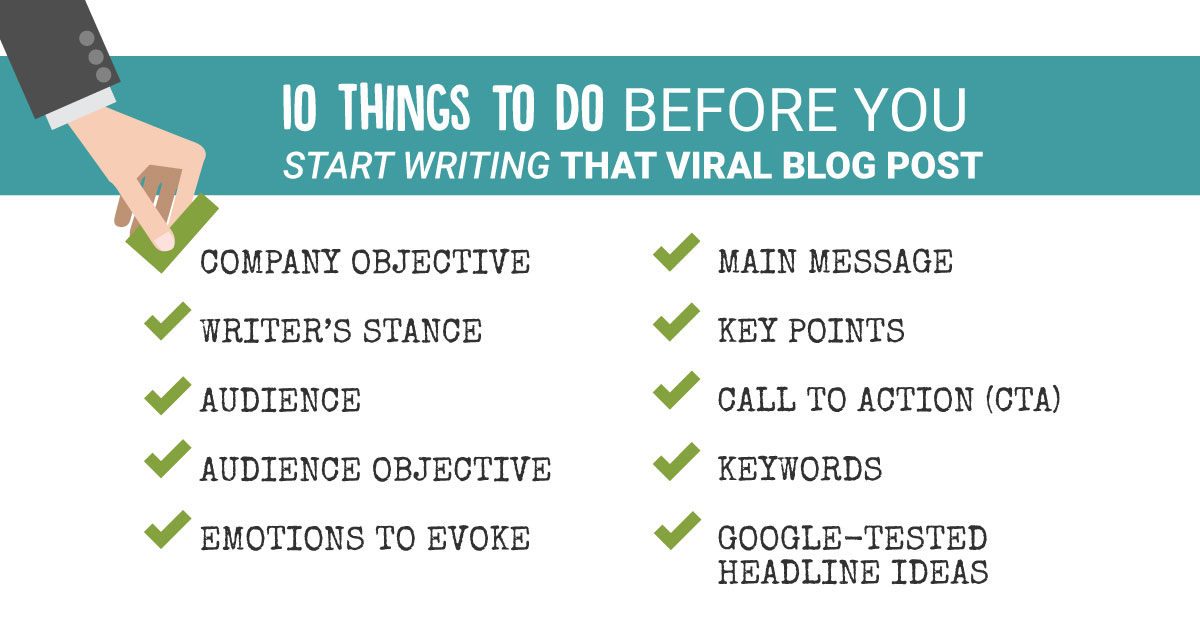This is part two of a two-part series. In part one, we covered the pre-writing process you can use to set up your blog post or content piece for success online.
In this article, I’ll show you how to take all that information and turn it into a compelling, high-quality article that people want to read and share, which will also help it rank better in organic search.
If you’ve done the planning process for a blog post and are feeling a bit overwhelmed, maybe wondering what to do with all that information now that you have it, no worries – I’ll walk you through what to do next.
This Is a Guide, Not a Formula
First, let’s talk about an important mindset to have as you go through this process.
Even though I’m sharing my secret writing recipe with you in these two articles, it’s important to not think of this as a formula, but rather as a guide. Even if you’re writing for business purposes, writing is still a creative endeavor. This process helps you balance the practical and artistic aspects of writing blog articles.
Use the Outline to Structure, Not Stifle

The key is to allow the structure of your article to be determined by the flow of ideas. This way, it has structure and readers feel like they are being led through a logical progression, all without stifling your creativity or turning out cookie-cutter content.
For instance, you can begin writing the article in a narrative, story-like format to engage the reader, and then build to the main message and the supporting details.
Or, for more informational articles, you may use a structure more like you learned in school – where you start with the main message in the opening, list the supporting ideas, and then close by reinforcing the main message in the conclusion.
So take a deep breath and relax as you move forward with writing and refining your blog article.
Headline Hacks for Beginners
You may write the headline first and use that to help you decide what to include in the article, but it’s also fine to write what you want to say first and then come up with the headline that best encapsulates what the article covers.
If you already have a great headline that you wrote during the planning process, great. If not, make sure you spend some quality time working on the headline.
The headline serves two main purposes:
- It entices the reader to click on the article and read it (so it should be enticing!).
- It promises the reader what he or she will get from reading the article.
It’s important when you’re writing a compelling headline to make sure that you can deliver on what the title promises. It’s also a good idea to verify that your finished draft will fulfill your audience’s expectations, based on the headline.
When brainstorming headline ideas, try this process:
- Write several headlines meant to be enticing to people.
- Write several headlines that have the keywords people will search for when looking for information on this topic.
- Review both lists of headline ideas and look for ways to slip keywords into your favorite people-friendly headline.
- Copy and paste your headline into an internet search and see what kinds of articles it will be up against. Is it the right topic, and is your article better than the ones that are already ranking?
If you’re new to writing headlines, Jon Morrow’s Headline Hacks is a good place to start. It lists the types of headlines that have been most successful over decades of use (they’re timeless) and how to use them, with examples.
You can download it for free on his website if you’re willing to submit your email address. You can unsubscribe from his list anytime, but if you’re serious about improving your writing skills, you won’t want to; he has great resources on writing for online audiences.
Begin with the Reader in Mind
I always recommend that you open your article by connecting emotionally with your audience and stating the problem or situation from their point of view. This communicates that you are going to talk about something relevant to them, and that you understand their feelings and the situation they’re in.
This can happen in the first sentence, or a few sentences in, depending on what makes sense. You’ll notice that in this article, I start of very practically by stating that this article is part of a series, but I still end the opening section by acknowledging that the reader may be feeling overwhelmed about what to do next, and providing reassurance that I’m going to make things easier for them.
Know Where You’re Headed
Think of writing as connecting the dots. You’re going to start with the audience’s problem/experience/feelings and then lead them through what you want to communicate to them, and finally to your call to action at the end.
When you sit down to write, review the information in your planning doc, and get a sense in your mind of how you want this article to unfold. Imagine yourself in the audience’s mindset and the journey of enlightenment you want to take them on.
For a refresher on the pre-writing steps I outlined in my previous post, here’s the 10-point checklist:
Get On Your Soapbox and Be Vulnerable
You may find it useful to write your article in chunks, and then piece them together in the revision stage.
For example, after you write a section connecting with the audience and what they need to get out of this, you can write a section that gets out what you need to say.
These days, people want more than information. They want expert opinions about the information as well. Unlike news stories that strive for objectivity, you can be as opinionated and emotional in a blog article as you want.
The key is to give compelling advice while also being authentic and personal. When done well, this leads people to trust you and like you, and want to hear more from you. The tone is totally up to you. It can be aggressive or compassionate, optimistic or cautionary, highly emotional or highly rational – as long as it reflects your genuine feelings on the topic.
Here’s an list of what to address when you write out the Writer’s Stance paragraphs:
- Your stance on the topic and why you feel strongly about it.
- Why you disagree with other approaches.
- A passionate plea not to make the kinds of mistakes you see people make in this area.
- An admission of mistakes you’ve made or misunderstandings you’ve had about this topic.
- What people absolutely must know to avoid the same mistakes.
- Compelling reasons why people should listen to you and follow your lead.
You can then either include these points all in one section, or spread them throughout your article. For example, if you’re writing a 10-point how-to article, for each step you might explain how to do the step and then why you believe it must be done that way.
Close Like a Pro
When you’ve made all of your important points, wrap it up with a closing paragraph or section that:
- Summarizes your main message and perhaps a key supporting point or two
- Has a call to action
If you began your story as a narrative, it is probably more appropriate to bring the story full circle and provide a satisfying conclusion to the tale. Articles that are more informational will summarize the main idea, yet still sprinkle in a compelling emotional component.
Post-Writing Checklist
Once you’ve written your draft and revised it to tighten up the structure, run through this checklist to make sure you covered all the key elements that will help it be successful:
- Did you start out by empathizing with the audience’s current situation?
- Did you say what you needed to say and take a stance, hopefully one that sets you apart?
- Did you make sure your main message is clearly stated, preferably more than once?
- Did you answer the questions the audience will have, especially if they are new to your topic?
- Did you explain things in layman’s terms, or at least define any industry jargon you used?
- Did you close with a clear CTA that flows naturally from the topic, fits with the buyer stage, and aligns with your goals?
- Did you do a search to make sure your keywords are included in the headlines and body copy?
- Does your article fulfill the promise your headline makes to the reader?
- Did you proofread for spelling, grammar and capitalization?
Tip: Have a coworker do the proofreading if it’s not your strong suit.
In fact, I highly recommend that you have someone else read your article before you publish it. A fresh pair of eyes will catch errors that you miss because you’ve been looking at it so much. And a fresh perspective may bring questions that you hadn’t thought to include, but should have.
It’s Your Turn!
Writing a blog article that gets read and shared online isn’t an easy task, but it’s worth the effort if you’ve got something of value to share.
Keep in mind that for an article to get traction online, it needs to:
- Resonate emotionally with your audience
- Provide excellent content (be helpful!)
- Use keywords selectively
Now that I’ve shared my process for creating compelling online content, I’d love to hear from you…
What is your biggest frustration when it comes to writing online content?
What comes easily to you, and where do you get hung up?
Share in the comments!




